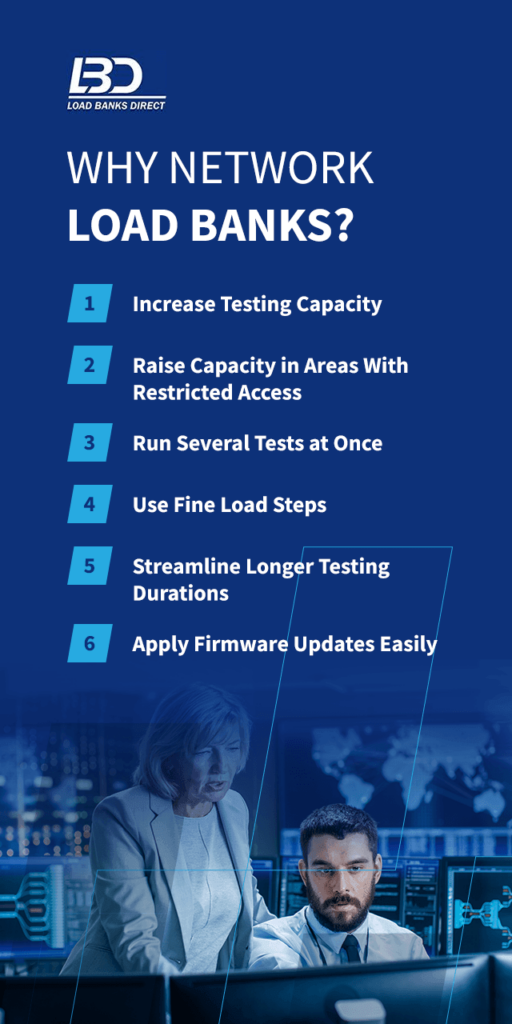
Many companies use load banks to test their power sources for functionality and quality standards. Grouping your load banks on a network can increase their functions and provide specialized care to many industries.

Why Network Load Banks?
Grouping load banks together to form a network can benefit operators. Understand the benefits of using a load bank network to determine if incorporating one into your facility can help increase efficiency and testing.
1. Increase Testing Capacity
When you use networked load banks, you can combine the power capacities from all units within the network to create a load banking system you can apply to the equipment at your facility. Load banks are essential tools across many applications, ensuring your equipment meets international and industry safety and performance standards. Networked load banks also ensure your equipment continues to function well by streamlining your repair services for higher-capacity equipment.
Increasing your testing capacity through load networking will work like this — if you use three 1,000kW load banks in your network, your testing capacity will increase to 3,000kW in total. You can then expand your applications with the equipment you have available or meet your facility requirements.
2. Raise Capacity in Areas With Restricted Access
If your equipment is somewhere that is challenging to reach, like on rooftops or in basements, you can use network load testing to ensure equipment quality and functionality. In these situations, bringing load banks with the right capacity up staircases or through doorways and elevators is challenging, so investing in a network load testing system helps ensure you can still test your equipment thoroughly.
Using a network enables you to increase your capacity for restricted-access areas, allowing you to connect to power units from a distance. This method will offer the right power capacity for thorough and accurate testing, and you won’t have to worry about fitting machinery through narrow spaces.
3. Run Several Tests at Once
Using several load banks together in a network can create higher power capacities to let you test your equipment. You can also group banks together to streamline testing by combining different types of load banks.
Many pieces of equipment may require you to run testing across resistive, inductive and capacitive load banks to gather different information. Mixing these load banks in one network allows you to test lagging and leading power factors at the same time for more efficient testing processes.
4. Use Fine Load Steps
Increasing your load capacity makes it possible to measure and test high-functioning power sources with your equipment. Intentionally grouping lower-capacity loads can also benefit your testing process. Grouping lower-capacity loads together results in finer, smaller load steps that can provide you with more precise testing processes.
When you use smaller loads together in a network, you can test for specific load percentages, giving you more precise results you need to ensure functionality and quality. This method can help you meet International Standard Organization (ISO) and National Fire Protection Agency (NFPA) standards for generators and power sources.
5. Streamline Longer Testing Durations
Each power source requires different testing lengths to gather the necessary information, and some can reach full days. You can ensure you collect that data throughout longer testing durations by networking load banks together and creating redundancy.
When you use multiple load banks to gather information during longer testing periods, you will increase your chances of at least one piece of equipment testing your power source at any given time. Because longer testing times can strain equipment, redundancy will allow you to continually collect data from your power sources by providing backups. If one load bank fails, the rest of your network will be there to finish testing.
This can help save you precious time and resources required to retest. Testing requires fuel, and long testing durations will take time away from your power source’s regular functions. If you outsource testing, it can also cost more money to retest. Networked load banks can prevent retesting by using redundancy techniques to keep testing going even if one bank fails.

6. Apply Firmware Updates Easily
Load banks require software updates periodically to maintain the highest standards and functionality. Updates take time to download, but they are especially helpful for ensuring your load banks can continually provide the best services and serve various applications.
When you use a networked load bank system, you can streamline your updates for increased efficiency. Especially if you already have multiple load banks, grouping them in a network will allow you to download updates on all of them simultaneously, making the process simple for your engineers and operators. You can upload and apply new or specified client testing parameters with ease.
Network Types
You can connect your load bank systems to various network types. Each has unique benefits that suit specific applications over others. Many will vary in their loading speed and distance. Reviewing the different load bank network controls can help you align which system will work for your power source testing and network function needs and requirements.
Further, many manufacturers will offer various communication protocols that they can install on their load banks, so you can begin communicating and controlling your system right away.
CAN Bus
Controller Area Network (CAN) Bus is a high-speed system with a relatively large coverage area. It will carry out tests and actions instantaneously across all load banks in the system, so you can efficiently test all power sources within your network. The fast result speeds are helpful when you want to include many load banks on this network.
Load bank CAN Bus systems are ideal for small portable or other non-permanent load banks. High speeds allow you to collect results quickly, so you can put more time and energy into transporting and preparing load banks for tests.
RS485
If you have more permanent load banks with higher power capacities in your network system, RS485 is a great network communication solution. Especially if you have fewer load banks in your system or only need to test a couple at a time, this protocol can help provide you with quality control and communication methods.
This network communication method receives information at a slower rate than CAN Bus, but it quadruples the control range, making it ideal for those with extended load bank network sizes.

Ethernet
This is one of the most common communication protocols for load bank networks because it is easy to use and efficient. The Ethernet network method will assign each load bank in your network a unique IP address, so you can easily identify and test specific loads within your system. The IP addresses also allow you to spread your network across farther distances.
When you install your Ethernet communication system, you will establish it in a control room at one of your facilities. From here, operators and engineers can access it to initiate and carry out load bank testing across the network. Ethernet is very helpful because you can have employees manually test load banks or establish automatic commands for a less involved but efficient approach.
Ethernet will help you control and communicate with your load banks, but you can also use it with other equipment, like compressors and transformers, for a more applicable investment at your facilities and across your networks.
Modbus
Modbus often pairs with another system, typically with RS485 and Ethernet protocols. This protocol offers better visibility and control over the different equipment in your load bank Modbus network and the data collected by gathering and filing information under registers and addresses. The protocol can even read and write data that it collects.
Controlling a Network
When you want to carry out testing across your network, you can use various control configurations to receive different outcomes and optimize the load banks in your network. The two most popular and common ones are proportion and individual control. As you are establishing your load bank network, understanding how the two controls work and their typical applications can help you determine which ones will work best for you.
What Is Proportional Control?
Proportional control splits power proportionally through load banks based on their power capacities rather than splitting energy evenly.
Consider a 1,000kW load bank paired with a 2,000kW load bank making up a 3,000kW capacity network. If you are testing a power source that uses 1,500kW, the first 500kW will run through the first 1,000kW load bank, while the 2,000kW load bank will process the remaining 1,000kW of power.
This is a standard network control method that allows you to prevent strain on your load bank units by directing power to them in a more sustainable approach. Redirecting energy in a proportional way to each load bank in the network will also help operators and engineers with any calculations they might have to do before, after or during testing.
What Is Individual Control?
Individual configurations give you more control over individual or groups of units within your system. While proportional control configurations split energy across your network, this method lets you choose which units you use and how much power you allocate to each machine for controlled, intentional actions within your network. When you use this control system, you can carry out tests that result in more accurate and precise data.
For example, this method is common with data centers because it helps mitigate the heat used on site. Because servers already produce a lot of heat, measuring the functionality of ventilation and cooling systems is vital for ensuring servers can maintain their lifespan, quality and function.
Common Load Bank Network Applications
Load bank networks benefit several industries and companies. Here are some typical applications for load bank networks you may come across.
1. Rental Companies
Many organizations choose to rent load banks from rental companies for a cost-effective load bank investment if they only need periodic power source testing. Load bank rental service businesses need to prioritize creating a versatile load bank selection to produce a strong network.
Having a network with more load bank types and power capacities can help a rental service reach more industries and companies, as it can better meet their individual needs.
Consider a company that starts by only offering a single resistive load bank. While this can meet many testing needs, adding a second resistive load bank can double the power capacity in the rental company’s network. Further, as it adds other types of load banks into the network, like capacitive and inductive, it will also increase its testing abilities. With a diverse set of equipment available and connected through the network, rental companies can reach more potential customers and provide more specific services.
2. Generator Manufacturers
Generator manufacturers have very strict quality and performance standards they need to meet when producing their equipment. Before selling each generator, they need to test them to ensure they meet their marketed performance standards with load banks. Generator manufacturers can create a load bank network to increase testing efficiency and put their products on the market sooner.
Networks can help program load banks to test for and record generator performance standards for their company or specific models. Easy updating will help manufacturers save money because they can update their systems to include new or improved testing capabilities instead of purchasing new load banks. Networks also help preserve load bank functionality since manufacturers can split power proportionally between machines to keep them functioning at their best.
3. Data Centers
Data centers need load banks to ensure their ventilation and cooling systems are functioning at the right capacity to care for servers. Many data centers create a strong network using several lower-capacity portable load banks at strategic locations throughout their server rooms. This allows them to quickly and efficiently target specific areas and power sources.
Grouping multiple low-capacity load banks together will create a larger power capacity, which data centers can apply to other power sources within their facility so they can test their generators and breakers. This group helps ease the urgency of maintenance for singular load banks — if a load bank fails, the rest of the network can help continue testing, giving maintenance teams time to arrive on-site and gather necessary equipment.
Networks also allow data centers to manage and control load banks across different locations for companies with multiple data centers to run.

Build Your Load Bank Network With LBD
Load banks are already essential tools for many companies to ensure their power sources perform and function at their standards while also helping enterprises repair equipment. Developing a load bank network has many benefits, allowing companies to increase their power capacity and make many testing processes more efficient.
Build and expand your load bank network with LBD. We are leading experts in the field, designing and manufacturing stationary, portable, duct- and roof-mounted, trailer and customized load banks, so you can find the right equipment to match your testing needs.
We choose the highest quality components for our load banks to ensure your equipment will have a long lifespan and withstand even the harshest conditions. Our tailored solutions can help you find exactly what you need for accurate and specified power source testing.
Contact LBD today and request a free quote.
We Are Here
To Help
Our team is here to support you and solve your power challenges. Connect with our responsive experts today to learn about our customized power solutions and products.


